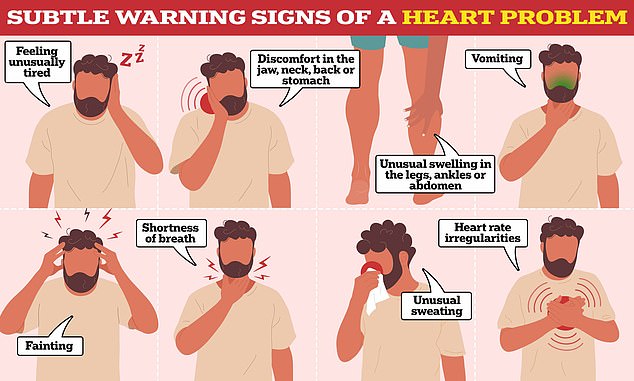Is standing the new smoking? Experts claim that standing upright for too long increases the risk of potentially fatal diseases
Don’t stand up for yourself.
In fact, a study shows that standing for too long does nothing to improve heart health and could even increase the risk of deep vein thrombosis.
Experts have warned for years that standing still for too much of the day increases the risk of a host of health problems, including weight gain, type 2 diabetes, cancer and even premature death.
Yet Australian researchers have now claimed that standing more than sitting does not reduce the risk of cardiovascular problems.
The scientists, who monitored the exercise patterns of more than 80,000 Britons, found that standing for two hours a day does little to increase the risk of circulatory problems.
A study has suggested that standing for too long does nothing to improve heart health and could even increase the risk of deep vein thrombosis

While some warning signs are easy to spot, such as severe chest pain, others are vaguer and harder to pinpoint
But the risk increased by 11 percent with each additional half hour after that.
Dr. Matthew Ahmadi, a public health expert at the University of Sydney and lead author of the study, said: ‘Standing for too long will not compensate for an otherwise sedentary lifestyle and could be risky for some people in terms of their health. circulation.
‘We found that increased standing does not improve long-term cardiovascular health and increases the risk of circulatory problems.’
In the study, researchers analyzed heart and circulatory data from 83,013 adults with an average age of 61, who wore devices on their wrists that resembled a smartwatch to track their movements.
After a seven-year follow-up, they discovered about eight percent had a cardiovascular problem, such as heart disease, stroke and heart failure.
Just over two percent reported a circulatory problem, such as varicose veins or deep vein thrombosis.
Their risk of circulatory problems was significantly increased, even after just a few hours of standing, the researchers said.
In contrast, the risk of circulatory problems decreased slightly between six and ten hours of sitting.
Every additional hour spent sitting for more than ten hours increased the risk of circulatory problems by 26 percent.
Sitting still for more than twelve hours also increased the risk of cardiovascular disease by 13 percent per hour.
Writing in the International Journal of Epidemiologyscientists came to the conclusion that sitting for long periods of time is bad for your health.
But they also recommended that people who want to reduce their risk of cardiovascular disease should exercise more regularly rather than standing for long periods of time every day.
Professor Emmanuel Stamatakis, a public health expert at the University of Sydney and co-author of the study, said: ‘For people who regularly sit for long periods of time, including sufficient incidental exercise throughout the day, structured exercise may be a better way to reduce the risk of cardiovascular disease.
‘Take regular breaks, walk around, go to walking meetings, use the stairs, take regular breaks if you’re driving long distances, or use that lunch hour to get away from your desk and get some exercise.’
It comes after data from earlier this year showed that premature deaths from cardiovascular problems, such as heart attacks and strokes, reached the highest level in more than a decade.
Rates of heart attacks, heart failure and strokes among those under 75 had fallen since the 1960s thanks to plummeting smoking rates, advanced surgical techniques and breakthroughs such as stents and statins.
But rising obesity rates and the associated catalog of associated health problems such as high blood pressure and diabetes are now believed to be one of the major contributing factors.
Slow ambulance response times for Category 2 calls in England – including suspected heart attacks and strokes – and long waits for tests and treatment are also responsible for the increase, which is also being felt by younger adults.
Despite claims from anti-vaxxers, cardiologists say fears that Covid vaccines could have fueled a rise in heart problems are far from the truth.
